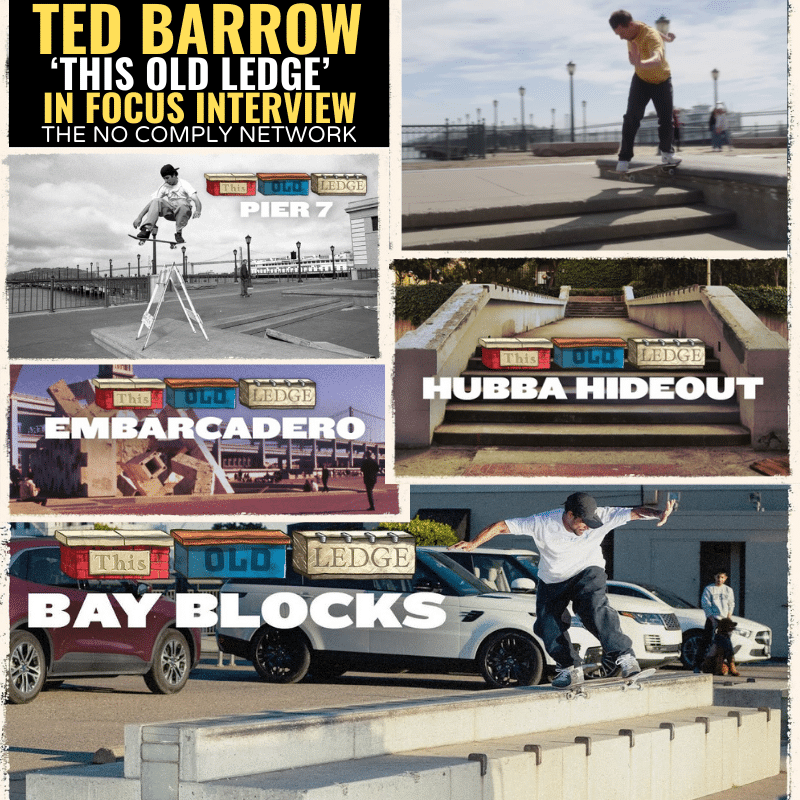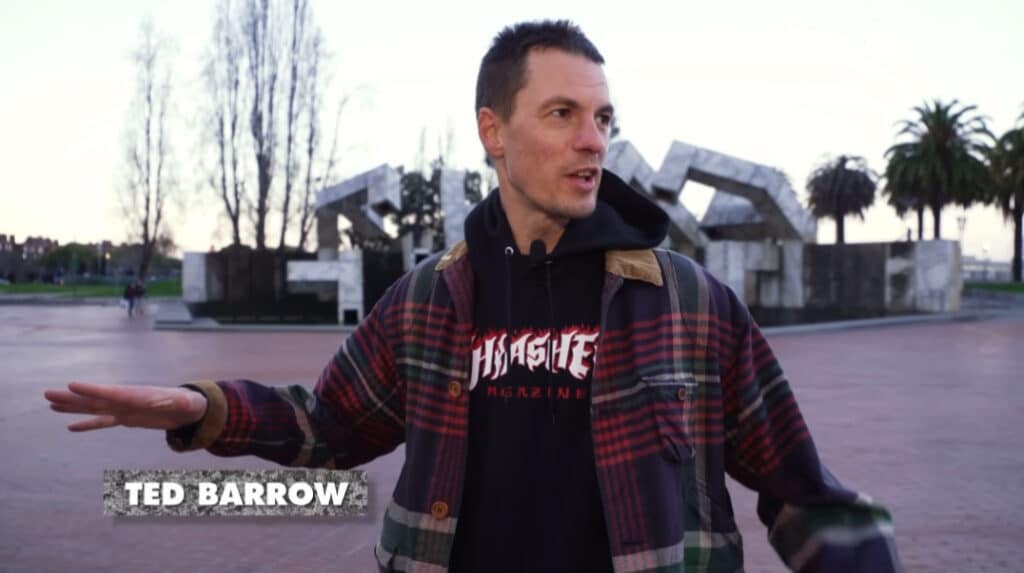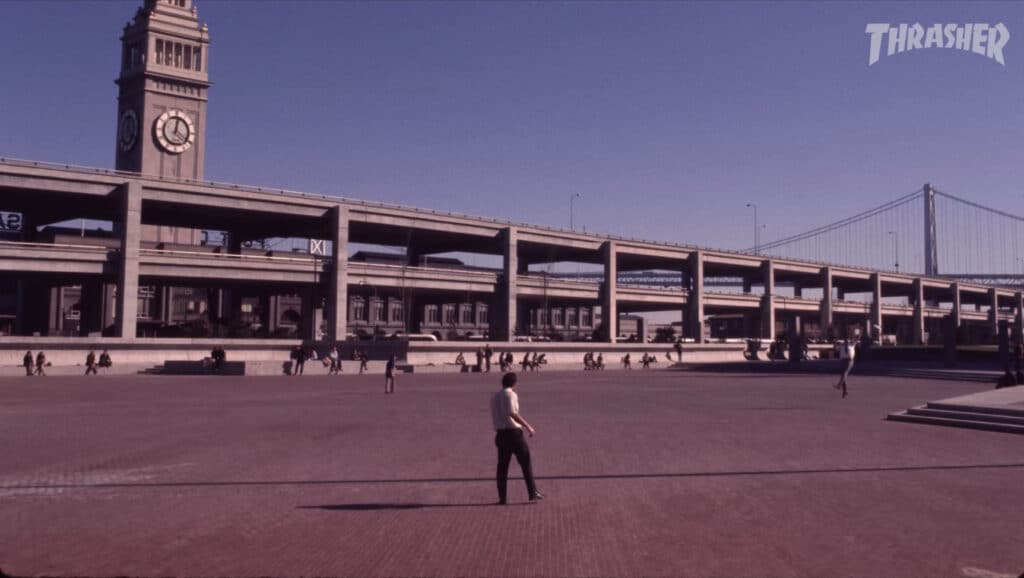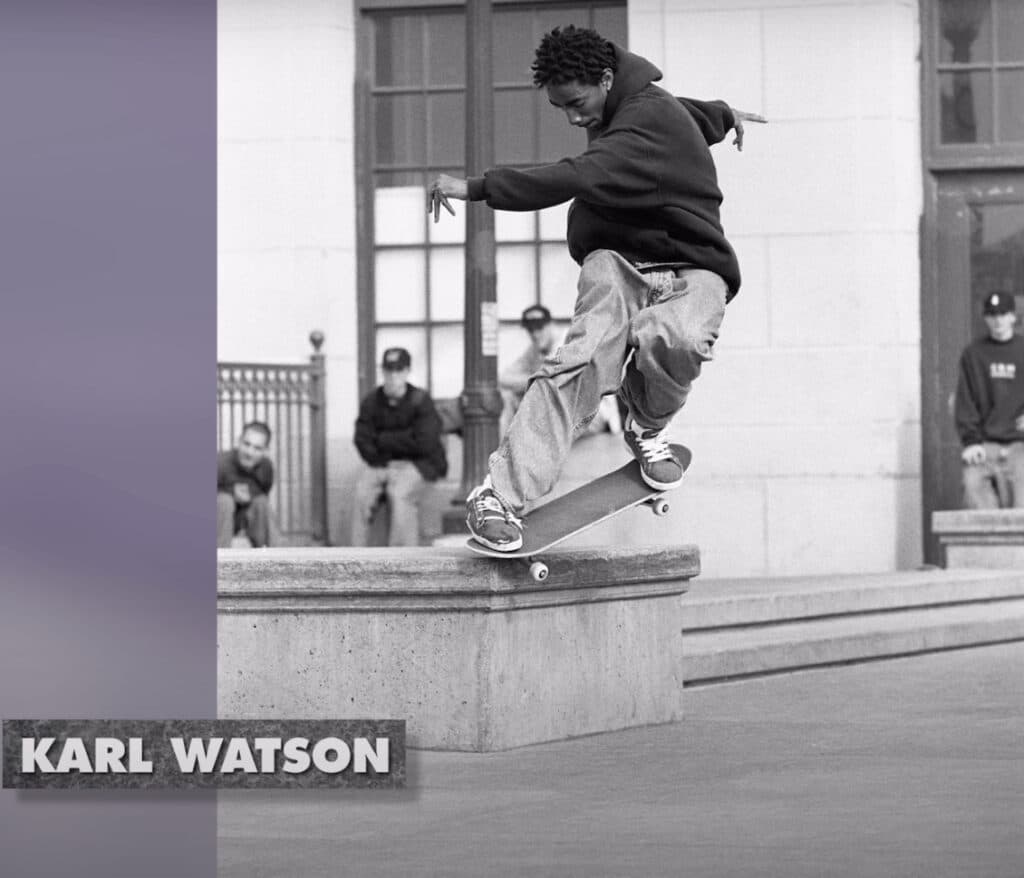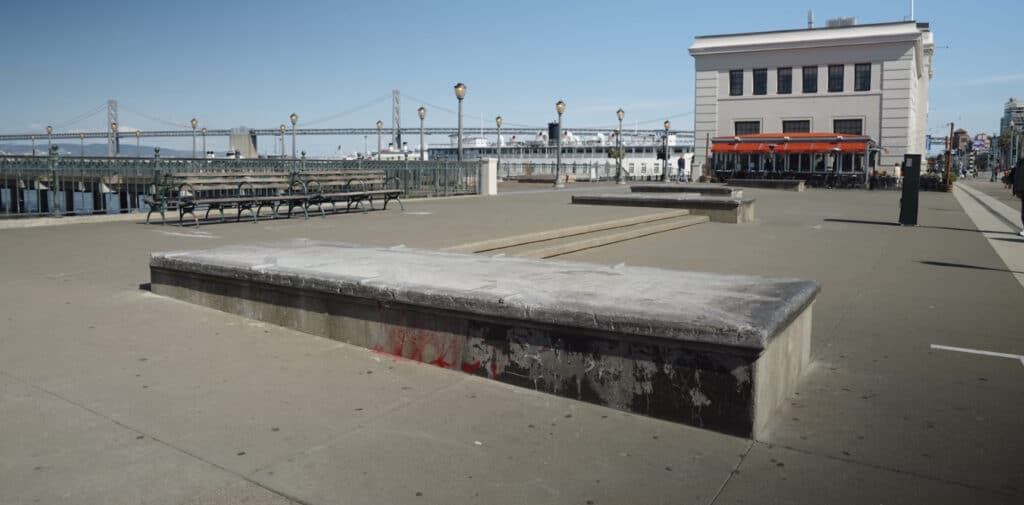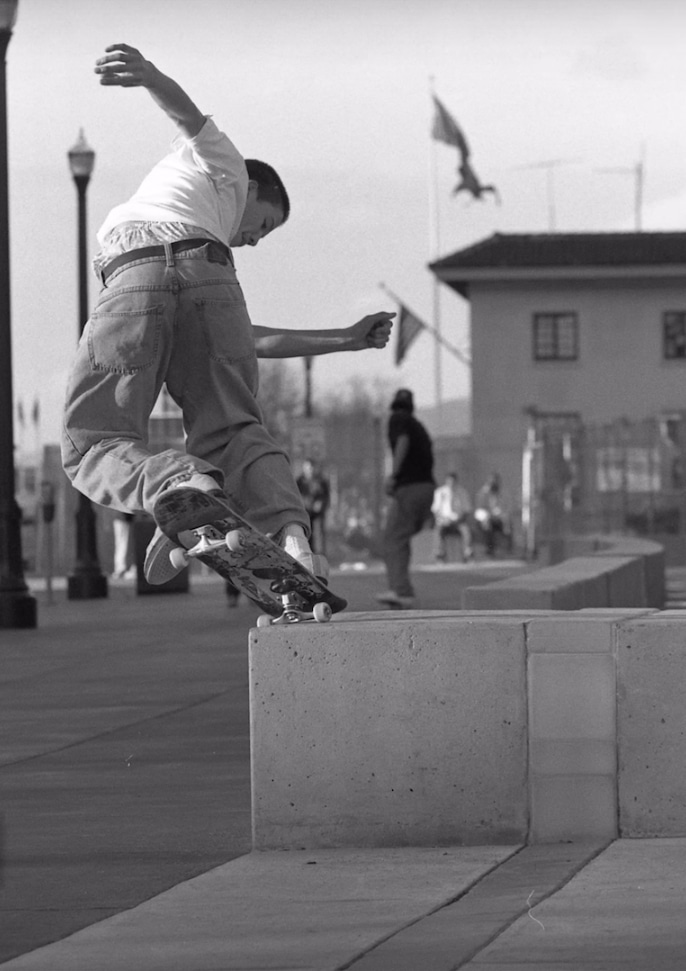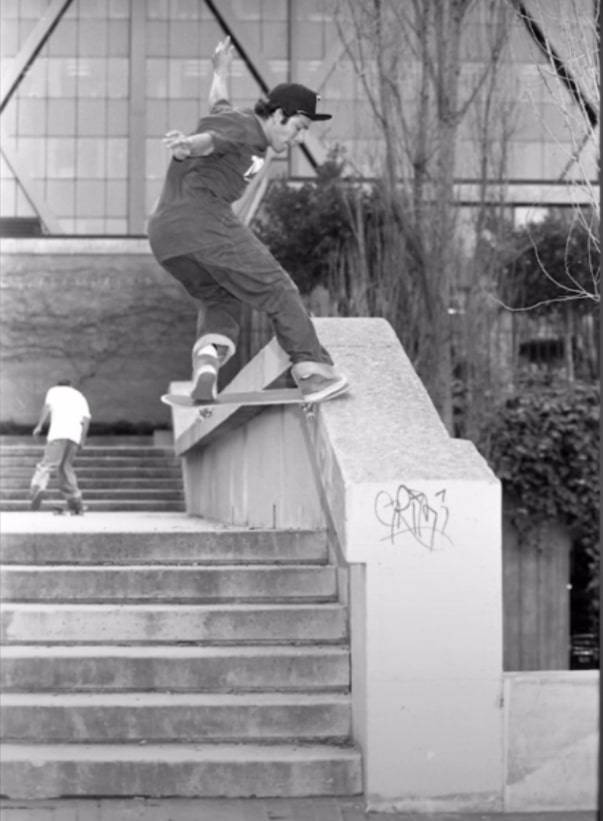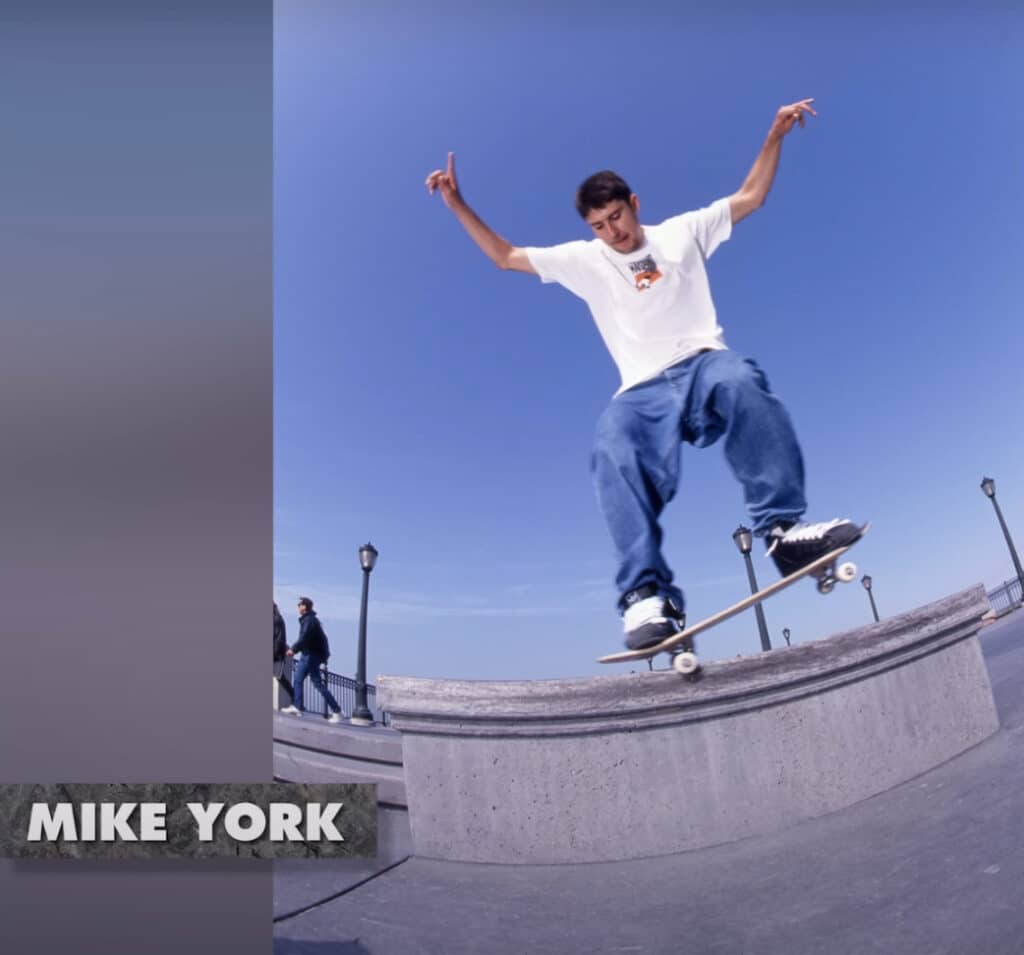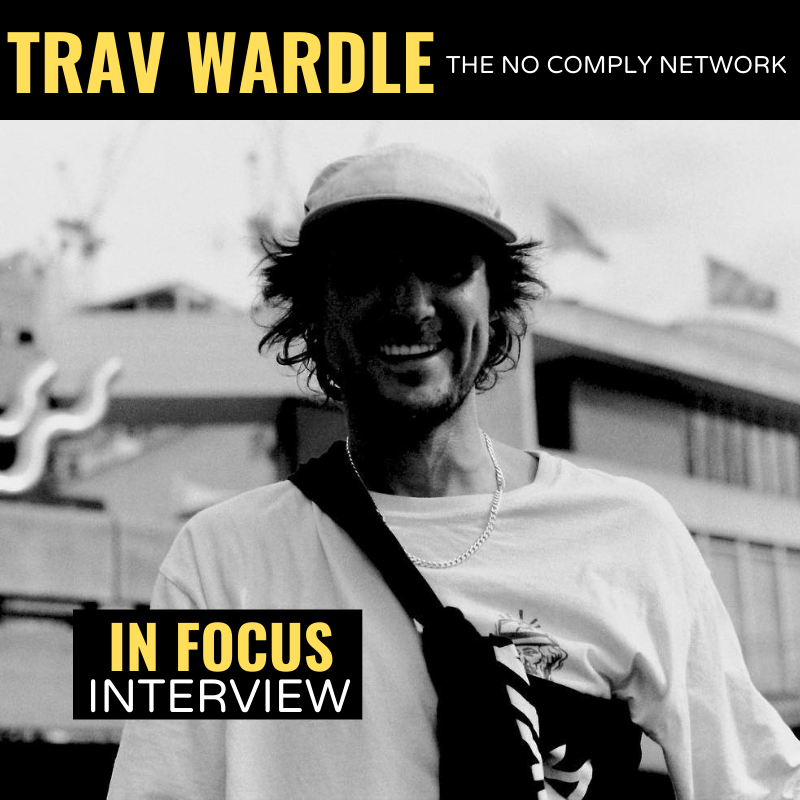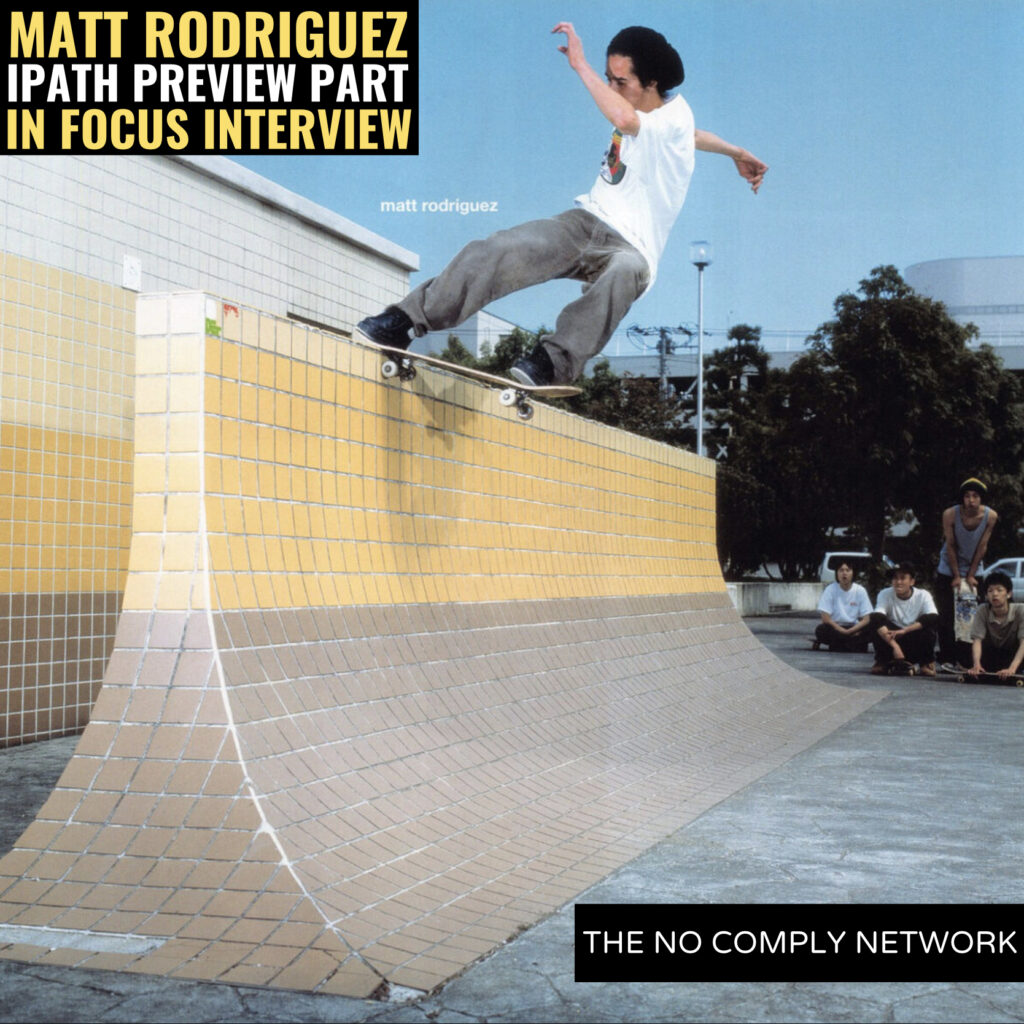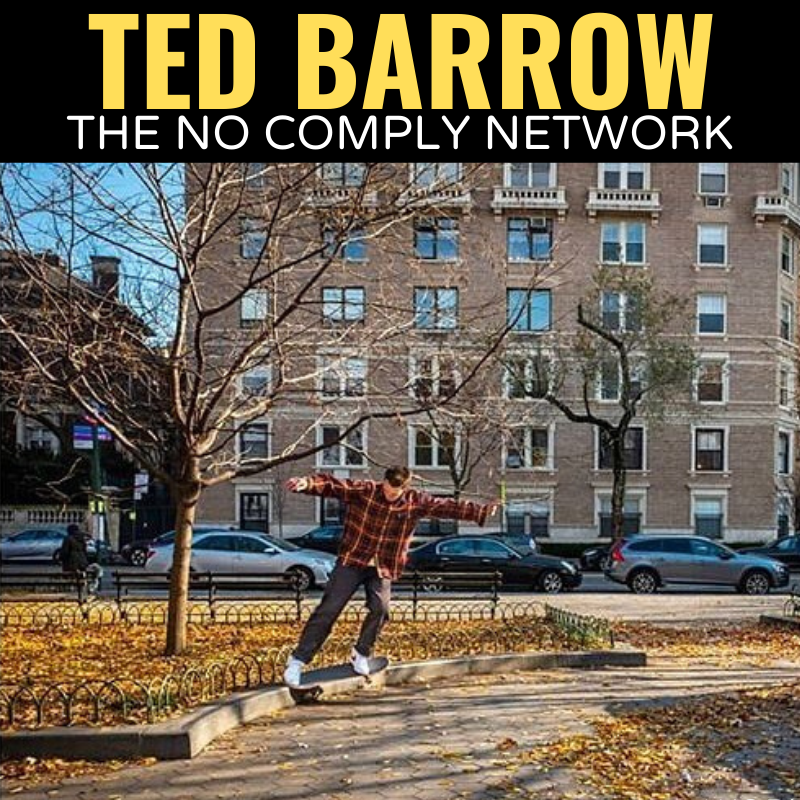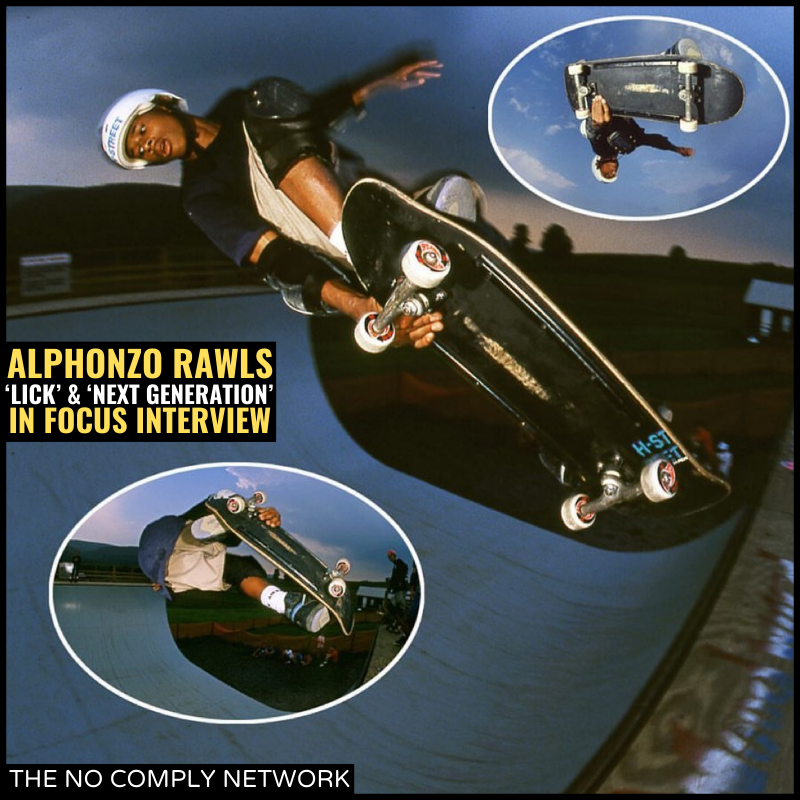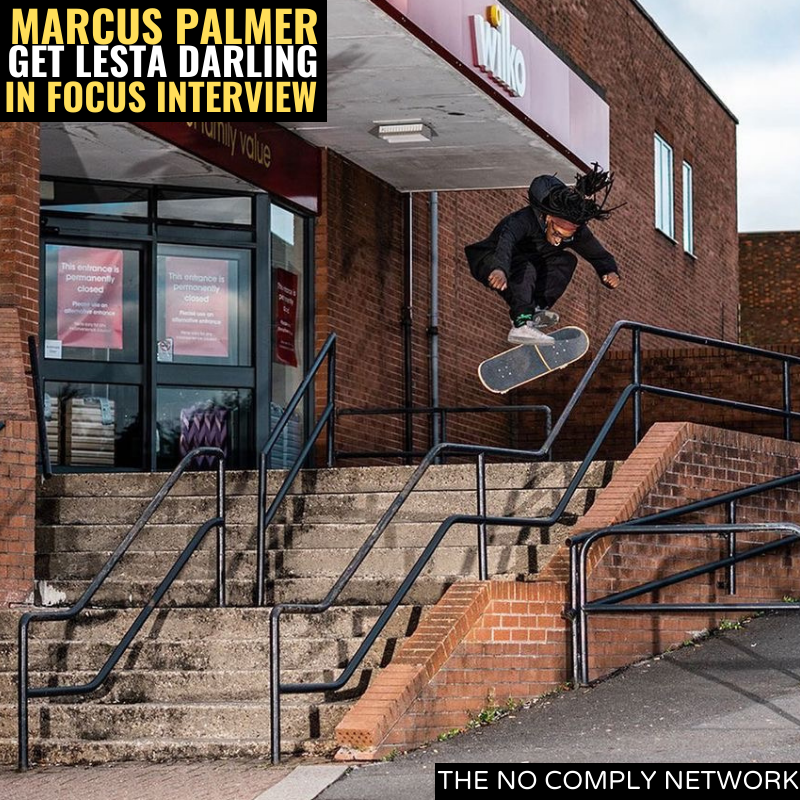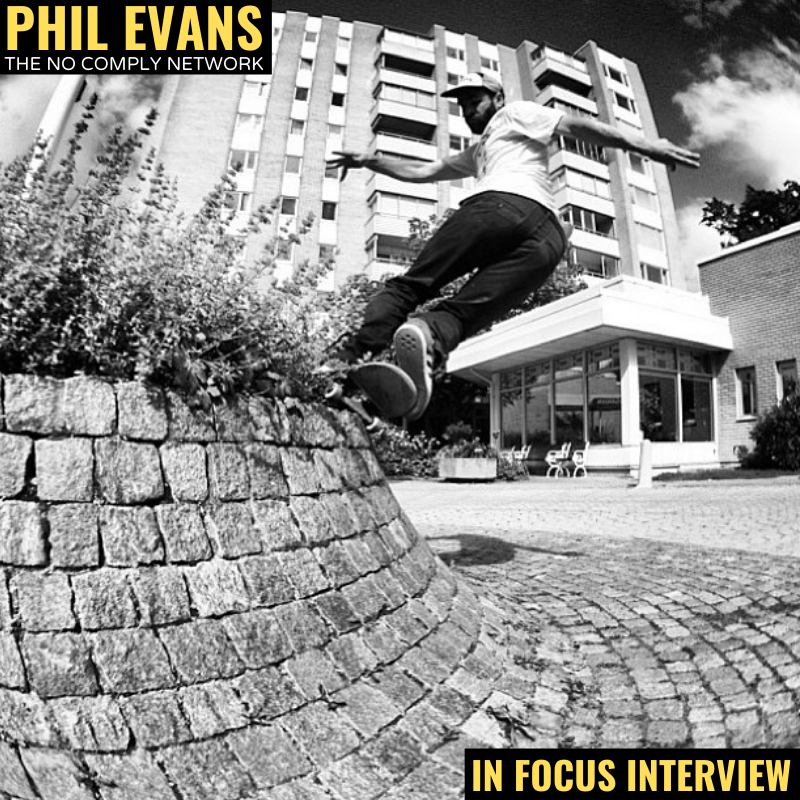Ted Barrow’s ‘This Old Ledge’ series for Thrasher thoughtfully blends skate history and culture through the lens of his experiences and well-researched storytelling about iconic spots. Ted’s exceptional ability to push a compelling narrative and passion for the selection of spots that he discusses, alongside his humour and wit, have made his series one of the most well-regarded of its kind in a short amount of time.
Ahead of the release of his upcoming new This Old Ledge mini-documentaries we were hyped to get the opportunity to catch up with him to find out how the previous season originally came to life and discover how the episodes on EMB, Bay Blocks, Hubba Hideout and Pier 7 were made. We found out what its like for him working with Brendan Bill to create them, how a DM from Will Harmon changed his perspectives on Pier 7 and also his thoughts on the differences between the East and West coast scenes, his reflection on his skate critique and reviews, his opinion on Gifted Hater’s videos, his plans to grow the series and his ideas about several episodes he’s planning on making in the future.
Read the Ted Barrow In Focus Interview below to find it all out for yourself and more.
Ted at EMB for Thrasher Magazine’s ‘This Old Ledge’: Shot by Brendan Bill
Since our last interview, you had just moved to California, so how have things been on the West Coast?
Yeah, things are fine on the West Coast. I think I’ve kind of grown into it. The last time that we spoke, I’d been in California for about a year. I was still very much wedded to this idea, of how life should be, based on how I was living in New York and I was maybe a bit frustrated and unfulfilled. But I’ve gotten older, we’ve all gotten older and I think that I’m settling into the pace of living in California. It’s nowhere near as exciting as living in a place like New York but for someone who is in their twilight years as a skateboarder and their middle age as an adult, it is very pleasant.
That’s quite interesting because from the English perspective, as we only get to see glimpses of American culture in general, New York seems just as rad as SF or Los Angeles. You’ll see crews of skaters ripping well known spots all over The States and doing sick tricks everywhere. So it’s hard to gauge what it’s like from here. What do you mean it’s a different pace of life?
I’m afraid I don’t know the UK well enough to make the analogy that New York is to London as ‘blankety-blank’ is to San Francisco or something. But I would say that New York is kind of the most hyped-up place in the world you know? It’s a world city. It’s a global city. People from all around the world have an idea about New York. Whereas California in general and San Francisco or Los Angeles, in particular, have their own kind of pace. It’s slower here. San Francisco where I live now, it’s definitely a dense layered urban place. But it’s all so completely specific to this region, its weather and the way that people act toward each other.
How do people in New York act differently to people in California?
People in New York are open, they are kind of aggressively courteous. It feels like no matter what you’re doing in New York City that it’s important and significant and it’s being seen by countless people and being shared with countless people and that’s why you’re doing it.
Whereas it is a little bit more quiet here. People are more private, people are more protective. It’s certainly harder to break into the different social scenes here – I’m talking about skateboarding and just all of the other different kinds of worlds.
People have private property, they’ve staked their claims and they want to keep it to themselves. Put it like this: New York is a city of immigrants, that’s the legend, the Statue of Liberty, people coming from all over the world, this is their first taste of the United States, it is the only place like that in the United States. Whereas San Francisco is a city of speculators and miners and people who have staked their claim on the land and want to extract their wealth from it. That’s how I would describe it.
Okay, so you’re saying that New York is faster and more cosmopolitan, where people go to achieve and make it, whereas, California is where people who’ve already made it set themselves up and chill more within their social circles.
It’s the same struggle everywhere, it’s just that the spirit in New York is collective and somehow selfless and the spirit of a city like San Francisco and even though LA is very different, it is kinda similar in that respect. The spirit is more like, this is mine, I’m not sharing. People are kind of more psychotic about how they are keeping what is theirs.
Is Oakland really that different to SF?
Oh yeah. Sure. I should clarify that I’ve been living in San Francisco for the last couple years and working here for as long as I’ve been in California. But it’s the same vibe. I mean think about it like this: Anyone in skateboarding who thought about SF from my generation, San Francisco is best known for its profoundly innovative but also very intimidating urban skate crew at Embarcadero. That was not a place where you could just come from out of town and feel welcome. Certain people did. Those people are much cooler than I am. But not everyone had that experience.
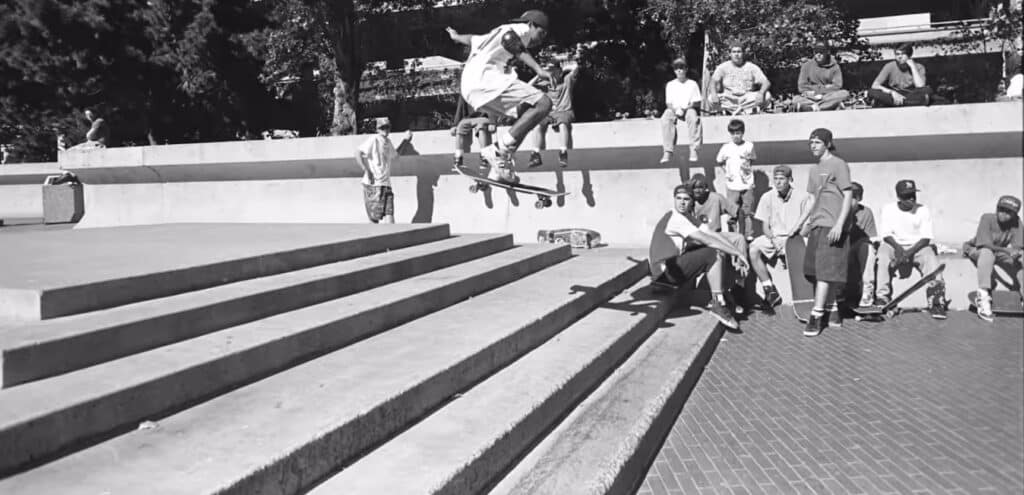
This Old Ledge: Embarcadero Episode Photo Archive (EMB Crew)
But yet it was profoundly influential. That EMB crew changed skateboarding. That was the moment when San Francisco was the centre of the skateboard universe and I don’t think I’m exaggerating when I say that. Whereas you could go to San Francisco and have a terrible time and skate all of the best spots. But I don’t know anyone who went to the East Coast in that era and didn’t feel a sense of being welcomed and being encouraged and accepted whenever they went to those corresponding spots. Be it Pulaski, Love Park, Copley Square in Boston, The Brooklyn Banks, Washington Square or Astor Place in New York. East Coast people just tend to be more welcoming than West Coast people. That’s the bottom line.
That’s funny because a lot of people who have never been to either place think the opposite to that.
That’s the image that’s projected versus the reality. I’ve always found that New Yorkers are much nicer than California people are. I have plenty of friends out here and I’ve been welcomed, but the vibe is a lot different let’s put it that way.
So that leads us on into talking about your opportunity to work with Thrasher as they are a North Cali-SF based company. How did you get that opportunity with Thrasher to make This Old Ledge?
Part of it is that I have had friends who have worked for or with Thrasher. So, it was not an out-of-the-blue type of thing where they were like ‘We like what you’re doing, what’s your deal!?’ sorta thing. They knew what I was up to. So it was partly that and it was partly that I was already close with people that worked at Thrasher. I think about it and over the years, I don’t know what people think about Thrasher outside of what I think about Thrasher. Whether they associate it with Jake Phelps and Phelps only or whatever. Or that people realise that Thrasher has been doing really interesting content that is about marking the history and highlighting the cool, weird stories that are in skateboarding.
That’s it’s not just face-melting bust or bail type of content, it’s all sorts of stuff. So I think in some ways we’re in this mode where we are starting to think about our history and we are starting to want to tell these stories in different ways.
So I think it is a natural step for Thrasher to want to work with me because that’s what I’m interested in. I thought about it, I’ve been a teacher, I’ve worked in museums, I’ve tried to find ways to tell these types of stories but this makes the most sense for me. I’m okay in front of a camera, I can tell a story, I can follow a thought and I can conclude it. I also have this weird nerdy brain that you know hangs on to skate minutiae and trivia in this obsessive way and I think that might help for this show.
Definitely. It’s the finer details in these episodes that you delve into that keeps people watching.You might be talking about architecture or skate history and then about broken beer bottles, or how people destroyed the spot, the grittier details that are cool to hear because it elevates those things to the level they should as skating is not all clean cut. It’s not just stuff you’ll see on Instagram. Fucked up stuff happens sometimes.
There are numerous ways to tell a story. I think in a lot of skateboarding, the storytelling has been this teleology, or causal approach. This trick was the best trick someone did and then that led to the next best trick that someone did. It’s definitely true and I’m all for progress in skateboarding.
But I also think that being an art historian has taught me how to think about what things mean or could mean. So it’s helped me to spin big stories out of seemingly insignificant things.
That’s the way that I’m approaching these videos. We’ll try to mention the best tricks that the best skaters did at a spot. But really it’s about how people skate spots and the less significant and less noteworthy things that I think tell more about a place. Because we’re not really talking about people, we’re talking about places in these videos. It’s a fun way to do it.
Certainly, other people have told stories like this. I always want to give props to Farran Golding for his favourite spot series and the stuff he does with Closer because I think that’s parallel to what we’re doing. In the sense that it’s about the appeal of a place. So I’m obviously sort of taking my training as an art historian and glomming it on to skateboarding’s history. It feels sincere and it feels fresh, so I like to do it.
Honestly, you can tell you have a passion for it. Of course, as skaters we want to see the technical and progressive side of how skating advanced, that’s rad but showing the cultural side of it, that’s what you managed to capture so successfully. The archive footage is a great addition. So showing the updated footage of you being there and seeing the current state of the spot and the changes that have been made to it, those two things in combination, alongside the classic footage creates a sense of what the spot is, what it was like and how it is now. The videos serve as a great piece of visual education for people who have never been there.
Also just knowing about a spot if you have not been there, enhances your appreciation for when you do go there. I do hope people make the trip to these spots because they’re important to our culture and we’re not sure why.
The SF episodes also work as a great advertisement of the city itself as a skate mecca. Watching them makes you want to go to SF and I’m sure it does for a lot of viewers. Some of the granular details you get into about the SF City Council and the decisions they made and why they made them are really interesting. So to talk about the production side a bit more, do you know which episode you were going to work on first?
Yeah. It’s a funny, long story. About a year ago, I think in fall in 2022, I went skating with Tony Vitello who runs Thrasher and I was telling him, oh did you know the same guy who designed this spot, designed that and that both of these spots have the same blah blah, talking about the materials.
Within a week, he was like hey dude, I have an idea, call me back. He was like what about a show called “This Old Ledge”, where you do just that, chat like a tongue-in-cheek antique show but you talk about the history of skate spots.
Thrasher had just done the China Banks mini-documentary, it was really popular and they realised there was an interest and a market for this. They were like hey we could do something shorter. The original idea was to have it just to be on Thrasher’s Instagram – a minute long video where I give a quick history on a spot
But because I had my experience, with putting out my content on Instagram through Feedback. I was like I can film them myself. We can overlay archival photos or footage and they will just be these quick little things.
And then I spent around three months trying to figure out how to film myself talking about a spot in less than a minute and it just didn’t work.
I finally came to the office with all this footage and showed what I had to the folks at Thrasher and they were just like, well, this isn’t going to work as an Instagram thing but this probably has legs on our YouTube. So we need to reshoot the footage, get the better archival footage and photos and then work on it from there.
The pilot episode was Embarcadero. I had a pretty clear idea that I knew we needed to do Embarcadero, Hubba, Bay Blocks and Pier, in that order, because that was the order that they were all built anyway. Chronologically.
So I’d say it took about two weeks of going out with Brendan Bill, who’s my main filmer and editor and filming the episodes together. He would just pick me up in the morning, we’d go to the spot, I’d skate a little bit and then I’d talk.
Then it took several months, tracking down the best archival footage and getting permissions and ordering great good scans of the spot from the library and all sorts of stuff that needs to be done and that I’m not very good at.
So I would say that we were probably done shooting the stuff in April 2023 and we released them in June 2023 and we’re currently working on a bundle of videos that we shot over the summer. I mean these things take time and there is no deadline but will probably be released hopefully in a couple weeks.
This Old Ledge: Embarcadero Episode Photo Archive (50s EMB)
So after you’d submitted the pilot, how long did it take you to shoot the first episode?
The EMB one that I filmed, the one that you see, is the first take, but there’s like 45 minutes of me talking that was condensed to 6 minutes. They take longer than I anticipated. That’s a very interesting thing to adjust to. Because when I did Feedback. I would be like hey, someone sends me a video and I can post a response in 5 minutes within most cases. It’s immediate gratification, you get that dopamine rush. Whatever. Whereas here. I get really excited about telling these stories and I can’t wait to see the response and then it’s a nice exercise in patience and delayed gratification to know these things will come out months after when we’ve recorded them.
Definitely. There’s something about putting some time into something and waiting to see the response. It makes it more special. Things are so here and gone nowadays. It’s better to wait, to get something that’s really quality, that people have anticipated.
In that respect, we are all learning, especially over the last few years, how unhealthy our relationship was to social media. I don’t want to speak for everyone. I’m just sort of noticing that we’re burned out on immediate posting and direct engagement and weird para social relationships we have with our content creators. We are starting to be a little more sceptical about that. At least I am anyway.
So for me, it’s very nice because one, this story will be told, this video will be released, it’s not about me, it’s about the process and its about the people I work with and the people who inspired this story and its kind of nice to be a bit hands off when it’s out there in the world. I don’t have to or nor do I want to read every comment and take that personally or one way or the other. I’ve felt lucky these episodes have had a positive response. But honestly, it’s none of my business. I’m doing it just to put it out there. I’m doing it because I believe in the mission. So it’s a different way of making content. I hate the word content but you know what I’m saying!
Looking back, it’s clear to see that Feedback was the launchpad for you to start doing ‘This Old Ledge’. Do you feel like that’s more of a healthy way to express your views on skating than the reviews that you did?
I feel very lucky that by hook or by crook I was able to get out of that cycle. Whether or not I have a healthy critical distinct from my persona on Instagram, it still dominated a big part of my life and that I was able to not only reject the negative part and embrace the positive part of – hey I still want to tell stories and have an outlet to do it – I feel extremely fortunate and I’m delighted that I’m still able to do this in someway. I never really wanted a place in skateboarding but I care a lot about skateboarding and I’m very happy to be able to tell stories about skateboarding for an audience.
Yeah, it’s no criticism of your reviews, but these episodes work way better for your style of commentary.
It kind of started creeping in after about a year of doing Feedback. I started telling long form stories, using that Instagram Stories feature and I was doing that because I really wanted to lecture about Art History. That was always kind of going on. But I was really just using the wrong app and the wrong kind of approach to tell those stories.
Instagram is the kind of place where we don’t really want to focus, it’s a place we go not to focus, it’s a place we go to for distractions and I was demanding for my audience that they stay with me, for however many slides I had, to tell my story or an analogy, related to skateboarding, art or something and that was part of the thing.
Plus, Jesus, even if it’s fun to give critiques and make those videos funny and get a good response, I did it for 3 years. It’s so exhausting. That’s the last thing I would want to do. Maybe I don’t have anything to say about that, you know?
I think there was a little period of gestation and in the meantime, I did finish my PHD and I graduated and I did accomplish the academic project that I was working on. So that’s great. But I could not imagine going back to doing Feedback and doing these new videos allows me to scratch that itch of talking about skateboarding and presenting it in a certain way, but it also allows me to be a full human, that doesn’t spend all day thinking about these videos.
Yeah, you seemed very determined, so it must have been a big change to stop and get out of that rhythm
But also, it’s just like anything in skateboarding great ideas have a life span of 3-5 years. Certain companies will be the hottest company that everyone is super excited about and then you kinda outgrow them, or then the ideas or what they represent become kind of stale after a while. It’s not the fault of the companies, or through any fault of the skaters who ride for the companies. It’s just that skateboarding kind of tends to generate new ideas and it can be presented in all of these different ways.
So I think one explanation for the fatigue that we’re talking about in terms of how we present skateboarding or how we think about skateboarding is from being skateboarders and being involved in this culture that is driven by the abilities and tastes of young people you know and young people outgrow shit! One year you’re dressed emo, one year you’re dressed like a roadman!
Haha
These things change. Everyone had their Dylan phase and then sometimes you’re gonna have your Heitor phase or whatever. So that like, I think that’s part of it and I think that’s’ one of the best things
Especially as an older skater constantly being attuned to and being aware of new ideas and new ways of thinking about skateboarding and approaching skateboarding and being a skateboarder has helped me through being a human. It is a progression-driven spot. I don’t mean it in the way that a Kickflip naturally leads to a Kickflip Backside Noseblunt but how a Kickflip leads to doing a different Kickflip every time you do a Kickflip and that recognition of how layered and how varied our culture is a good way to approach how we make stuff and why me make stuff.
Yeah skateboarding since the 70s is all layered on top of each other and each new generation adds their own twist onto what the last has done. You look back at the core of what those things were through spots. Spots are mainstays, they change, but not the influence they had. Making your episodes did you find anything out about a particular spot after a bit of research like Hubba for example, that stood out for you?
In each one actually, there would be something that I learned while researching the spot that continued into a new idea after I’d wrapped the episode which was always frustrating.
I’ll give you an example: I talk a little bit about Barbara Stauffacher Solomon in my Pier 7 and Bay Blocks episodes and she was this very important graphic designer, who combined pop art – the crisp signage and typography of American Pop art with the large scale of abstract expressionism – like mural-sized logos basically. But she was also an artist, she was a writer, she was all these things, she was amazing. I came to really appreciate her while I was researching her impact on the Bay Blocks.
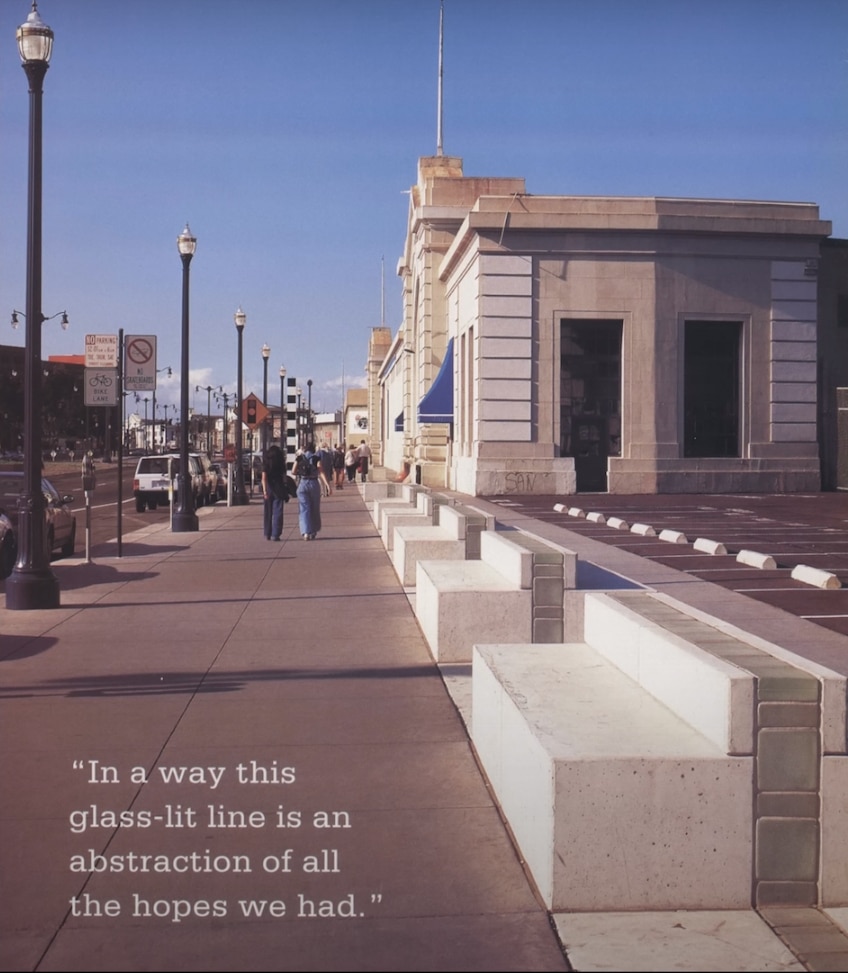
This Old Ledge: SF Bay Blocks Episode Photo Archive
She was part of a consortium of artists and designers who designed that 2 and a half mile long art installation that became this spot. When it passed through Pier 7, those blocks had metal edges on them and I never knew why they had metal edges on them and only after the episode aired did I get an email from of all people, Will Harmon – whose father is an architect.
He told me that his father had met Barbara Stauffacher Solomon 20 years ago and that when she found out that his son Will skated, she said, you know I was responsible for putting the metal edges on those blocks as they passed by Pier 7 because I knew that skateboarders would go there but I didn’t want to tell anyone that I was the one who did it because there were liability issues, and we were already in trouble with the city for X, Y and Z.
But it’s just you know, all of that is to say, yes in the course of research you relearn and find out surprising things that you would never have thought before that are adjacent to skateboarding, are central to skateboarding or that I just don’t know. It’s also just to say the history that I’m telling, is not the end all -as in this is the last word – it’s just one way of thinking about these spots. I try to be as diligent and thorough as I can. But by no means am I telling the ‘full story’ of these spots in 6 minutes. It’s more like hey, this is a topic about this spot that I think is very interesting.
Yeah for sure but you do a great job of weaving together a strong narrative.
Marcus McBride or Henry Sanchez, or Karl Watson or whoever will have their history and their story, which is equally as valid or more so than what I am telling.
This Old Ledge: Pier 7 Episode Photo Archive (Karl Watson: Nollie 180 Crooked Grind)
For sure. We all look at things differently and what they did there was so unique to them, based on their experience, even though we can be in the same place we are all experiencing it in a different way and videos changed everything. So in terms of This Old Ledge’s production, the intermeshing of the videos and photos, and your presenting, at what point did you start to think of particular photos or videos that you felt had to be included?
Yeah, One person’s appreciation of a spot in skateboarding always has everything to do with when they were sixteen and really excited about who was skating there, you know like, I don’t know if kids think of Nick Jensen in London and the way that I think of Nick Jensen there. My crew of Southbank skaters for example is informed by who I saw in 411 in 1992 and 1994, who were skating to the London Posse, in the world global reports in 411vm, that’s who I associate with London’s skating. Whereas someone who started skating in 2003 is going to have a completely different roster of skaters that they associate with London and a certain spot.
So in the same way, one of the things that I was thinking about this morning, was that there was this amazing era of people skating in EMB before it got shut down. Where Josh Kalis, Eric Pupeki and Matt Pailes were maybe the first generation who moved to San Francisco in order to skate EMB because they saw Mike Carroll and Henry Sanchez skate it in 92 and 93. They were skating the higher ledges, they were skating it in a different direction.
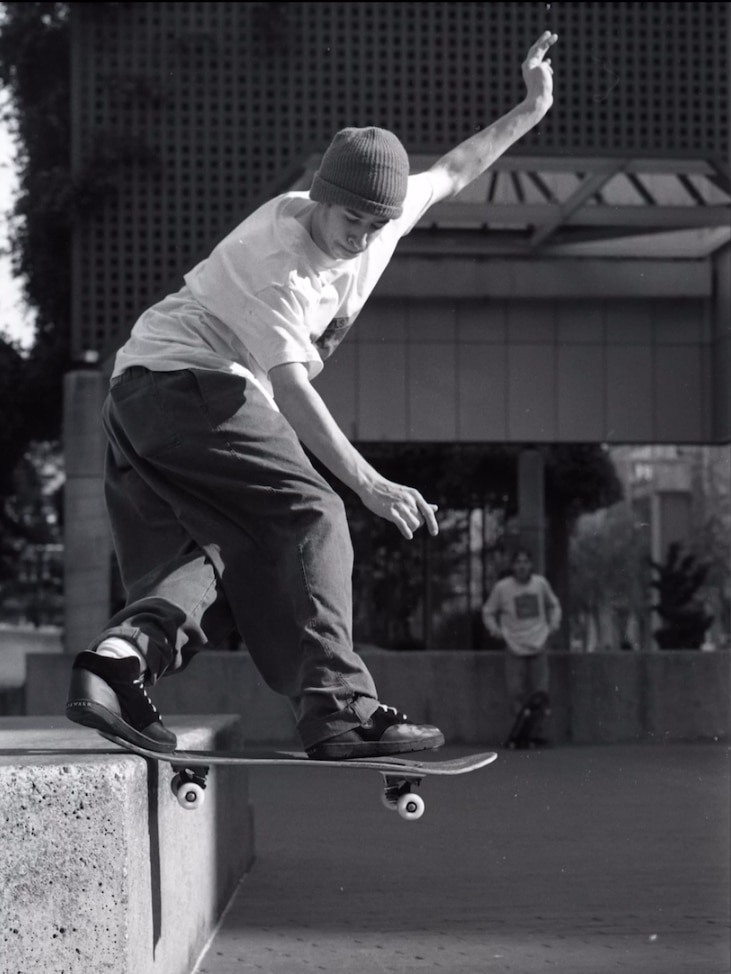
This Old Ledge: Embarcadero Episode Photo Archive (Mike Carroll, Backside Talislide)
Josh Kalis’ Toy Machine part is such a cool approach to skating that spot, it’s paying tribute to that spot but skating it in a different way. The great thing about skateboarding is that you can get into a spot, through a trick or the style of one skater and then you can recognise how someone else skates it totally different. It’s like a gateway to more interesting and nuanced approaches to the culture.
If you’re asking me what the sort of emblematic era of EMB was for me, it was that shit when skaters from the East Coast, like Erik Pupeki and Keith Hufnagel, Scott Johnston, when they started skating Embarcadero, Drake Jones. It was seeing these different styles of skateboarding all applied to this one same plaza. It was like the petri dish of a scientific experiment of skateboarding’s progression and seeing someone who has a different skate background skate that spot was really exciting.
In the same way that I think Lavar and Marcus really came into their own in the Pier 7 era and seeing those guys skate EMB was amazing. It does not get much better than both of those guys skating those ledges, for me.
It’s you know, I also sort of thing, maybe I’m stuck in this mode. I have a theory that skateboarding at the end of the millennium went from being this subcultural thing to this mainstream thing after the turn of the millennium and we’re all still looking at the 90s as our golden era. I think that will always be the most classic era. I think if you ever started skating in 2010 you’re going to rediscover the 90s and the 90s will make sense to you in a way the 80s would not.
The 90s was definitely the birth of modern street skateboarding so I would agree. Kids can skate virtually anything now, their abilities are off the charts because of their access to solid skate facilities and also by clearly being able to see what has been done so they can do it themselves.
Yeah and they do it in a style of their own, if a kid grew up with a skate plaza, that plaza was designed to replicate the real plaza from the 90s that you can’t skate anymore. So kids who weren’t born in the 90s grew up skating obstacles that were thought up in the 90s. Not saying that about kids who skate from Southbank, EMB, to Pulaski as they are all 60s, 70s and early 80s designed plazas but the skateboarding happened in the 90s in these places. So kids learn these tricks, I know they skate differently but I think that era will always be the classic era. The farther away we get from it, the better it looks.
Yeah hubbas are renamed after the original Hubba Hideout not every kid knows that but you need to capture that history and preserve that.
Exactly.
Skateparks have a different mentality and approach to street skating.
I would never say never but it has not occurred to me in all of the episodes of this Old Ledge we have done so far that I would ever do one at a skatepark. I don’t want to invalidate skating at a park because I like to skate parks and shit. But I think that skating is more meaningful and it is more authentic when it is done in public space or it is done in a space that was not designed for skateboarding and that we have found a way to make it a space for skateboarding.
In those moments when skateboarding as an activity is being tested and you have to find a way to fit it in within what everyone else is doing, that’s when skateboarding reaches its radical form. That’s where it’s presented. When you have to negotiate with people on the street. When you have to figure out who’s skating what ledge and how. That’s when skateboarding starts to make sense to me. You can have the same sort of challenges skating a skatepark ledge with a metal edge, like sure absolutely but that’s like working out versus playing the sport. It’s like training.
This Old Ledge: Pier 7 Episode B-Roll: Shot by Brendan Bill
Everyone has their approach and their own excitement level. I definitely prefer street skating but there are a lot of advantages to skating parks, and not getting kicked out is always a good thing.
I’m not saying one is better than the other. But it’s okay for me to think one is more exciting to talk about than the other. Didn’t I already just spend like three years talking about people’s skate park clips? It’s time to move on!
Yeah you’ve moved on from the parks to the streets, it’s a lot more rad
It’s a lot more dangerous
But it’s worth it. You’ve got a small team working on This Old Ledge. So what’s your relationship like with Brendan Bill? Does he have a lot of input into what he wants to film for it or do you direct the visuals?
I was so impressed by what he’s able to do that I don’t feel comfortable telling him what I should do because he has such a better idea and better eye than I do. But one of the most helpful things about working with Brendan, aside from the fact that he’s so capable and that he works really hard, is that he will know who did what and where over the last 10 years of which I’ll have no idea because I’m an older head.
He’s also got experience of the idea of what the video should look like before we even film it. So he’ll know when to say this is time to wrap it up or say it this way because you already said that. So he on the spot does editing for me or on the spot helps me to say what I’m trying to say.
But on the other hand he’s also very patient and allows me to go off on my poetic flights of fancy if I need to. But early on I showed him a couple of videos of what I had in mind of how I think the videos should look. They weren’t skate videos, they were just art videos about people speaking about the city or something. He quickly recognised what he could use from those videos to make these This Old Ledge videos and how his would be different. I love how his b-roll looks. I love how he incorporates the archive footage. I’m so glad I’m not the one doing it.
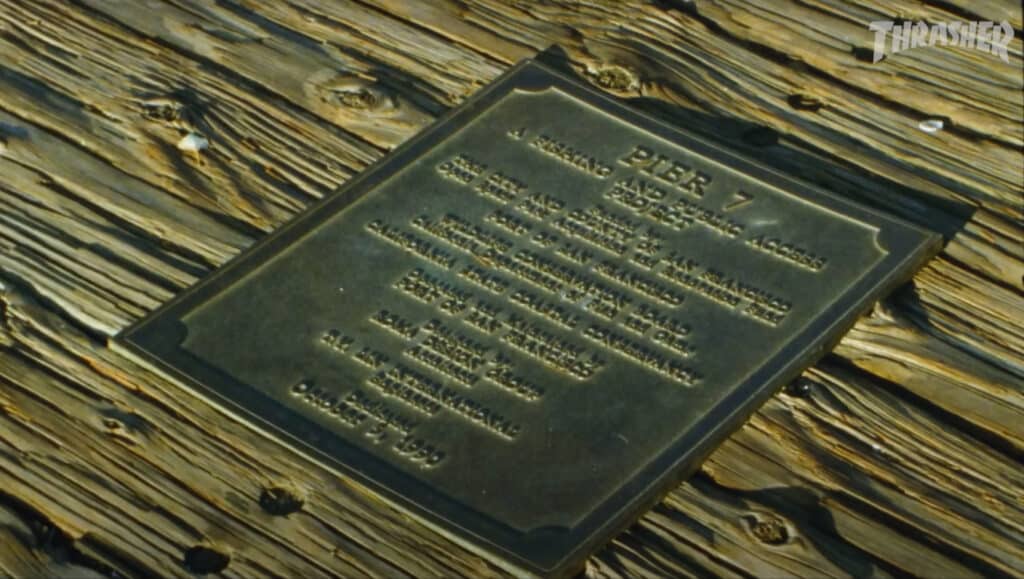
This Old Ledge: Pier 7 Episode B-Roll: Shot by Brendan Bill
The only challenge of working with Brendan is that he also plays a major role at Thrasher and he was just off on a major skate trip to the East Coast for like a month. So I can’t just text him in the middle of the night and say “Hey, I was thinking that we could have Anthony Correa’s Switch Backside Flip on the banks!” Or whatever you know? Because he’ll be like dude, I’m partying with Miles Silvas leave me alone hahaha
That’s just to say, my role is pretty minimal in this thing, I’m just the talking head. It’s all about Brendan, it’s all about Doug, the people who look into the archive, It’s about the skaters and filmers who did this stuff, I wouldn’t have any story to tell if it was not for them.
This Old Ledge: Bay Blocks Episode: Satva Leung Backside 180 Nosegrind
True but you do play a major role in it. Has there been a standout moment for you while making an episode?
It’s been kind of funny. We were in New York filming a handful of episodes and at most of the spots there weren’t skaters there but we went to one spot and there were 20 skaters there, I felt so self-conscious being there narrating a spot while they were there. I was just like oh jeez, I am my worst nightmare. If I was skating that spot I would be like what the fuck is this guy doing!? That hasn’t happened that often. I try to be respectful of people skating there. What they’re doing is the most important thing. So we’ll come back if that happens.
Here’s a funny one actually. To wrap up the Pier 7 episode. Brendan really wanted me to get a trick on one of the ledges. At this point in my life, I’m 47 I can barely get up on a ledge and so I was just like ok ok and Pier 7 is not an easy spot to skate.
So we showed up and Franky Spears was in town. So Franky is in the car and we drove down and I am struggling with a Switch Backside Tailslide up one of the ledges and Franky is just fucking around casually Caballerial Backside Noseblunting it.
Several people have done a Caballerial Backside Nosebluntslide – 25 years ago and it was mind-blowing. Rob Welsh, whatever, but he’s just doing it for a joke, it’s not even good enough for his Instagram. Whereas I’m just struggling to do a Switch Tailslide that would have been easy for me 2 years ago and that Karl Watson did beautifully in his Mad Circle part.
There are things like that that are very humbling. But it’s also just like hey, we’re all skaters and it doesn’t matter. The whole point of the show is that great things happen but that’s not the only thing that happened here, all skateboarding that happened here is important.
That leads us really well onto the Hubba episode. You Crooked it at the end, that was rad, even for now.
I Crooked and BS 50-50’d it. Neither were good enough to film but we figured we’d throw it into a doubles clip with me and my friend Zach back then. I used to come out to San Francisco from central Texas. I’d come out in the summer to skate Embarcadero or get abused by the cool guys at the spot.
So then my friend Aaron and I, in 1993, we were in SF and we decided that because we were at the Carl’s Jr that used to be at the bottom of the hill by Hubba Hideout and we were looking at Hubba Hideout, we were like dude let’s just go up there and look at it.
We got up there and we just started Ollieing and jumping and landing on top of the ledge on our feet and kicking our boards away. Little by little we got into Noseslide. You had to do the highest Ollie you could ever do to get into a Noseslide on this thing. We’d get into Noseslide and our hands would be down and then finally we both managed to Ollie, land in Noseslide and slide and land without putting our hands on the ledge. We were both like shit we both just managed to Noseslide Hubba Hideout.
But again it’s 1993, that’s the year that Virtual Reality was released and Pat Duffy had done Kickflip Noseslide down Hubba Hideout and by no means was a Noseslide down Hubba Hideout a good trick – but we did it.
Early on, we had experience skating this scary spot. So the Crooked Grind down Hubba Hideout. I mean Wade Speyer did the first trick that was shot down Hubba Hideout, this was a Nosegrind down it in 1991. So I knew that in no means that it was going to be cool.

This Old Ledge: Hubba Hideout Episode Photo Archive: Wade Speyer
But I had this friend called Eli that I skated with in LA in my first year of college in 1996. He was a really good skater but he would also just claim tricks. So Eli told me that he wanted to do a Hurricane down Hubba Hideout and I kinda knew that he was full of bullshit. I was like alright dude I’m gonna drive you up to San Francisco and I’m gonna get a filmer and you’re gonna Hurricane Hubba Hideout, like put your money where your mouth is, let’s do it. So we went up to San Francisco. I called up my friend Zac Hudson, he called up Satva Leung and he showed up with his camera and we got there and Eli will not roll towards the Hubba.
So Zac and I are just like whatever, alright we don’t want you to waste your time so let’s film a doubles. Zach Boardslid it, I Crooked Grinded it. I was 20 years old in 1996. I was at the top of my skating at the time. I’d never sprain my ankle. I could Ollie High. I could Backside 50-0 it. I Crooked it. Neither of those tricks seemed that good and they weren’t but that was the last time I skated hubba.
A few years later in 1999 or 2000, I was on a trip with some friends from LA again. I thought about Switch Backside Tailsliding it because I knew that getting onto Hubba was about as a high as the high ledge at 3rd and Army and I could skate that one pretty easily. But I was also like why? I just thought that Josh Kalis did it already beautifully in Timecode. There’s no reason for me to do this trick. I was right. This maybe sounds like I was claiming but I was pretty sure I could have done it. It was one of those spots, where you’re still in the 90s where you shouldn’t do something that someone else has already done. But it’s also thrilling to do anything on it.
This Old Ledge: Hubba Hideout Episode Photo Archive: Mark Gonzales
Yeah totally. There are these unwritten rules in skateboarding.
I got some pushback when I ended the Pier 7 episode when I ended it saying this was a place where you really could not try someone else’s skating and the reason why the footage from Pier 7 looks as amazing as it does from that era is because that this was the first and best time that someone had done these tricks and you need not see anyone else do those tricks there because you’ve already seen it done by Henry Sanchez or whatever.
People were like “skateboarding shouldn’t have rules!” and “that’s so stupid people wouldn’t let people try their tricks!”.
It’s like yeah, from the outside it’s maybe a bit ridiculous, but you’ve got to understand, it’s about respect, it’s about valuing the culture and not playing it out. I think it’s very hard for a teenager raised on TikTok to understand now. I’m not saying the old-school position of ABD is relevant anymore but I think it is the reason that the skating from that era was either good or bad because it set the bar back then.
This Old Ledge: Pier 7 Episode Photo Archive: Mike York, Backside Nosegrind
Nowadays it can be more about replicating things that are seen as good rather than new or original things.
I spent a lot of time thinking, the 90s was this idealised time, where we were all weirdos and stuff. But also I do remember that in 1989 every street skater wanted to skate and look like Matt Hensley. In 1992, every street skater wanted to skate and look like Mike Carroll. Or whoever. There were always a handful, 2-3 skaters who were everybody’s favourite skater and that everyone tried to emulate and through that emulation we found our own lane. We found our identity.
It’s almost like a stage of development as a young person. You have your favourites. You have your para social bestie that you pay attention to and who you want to be like and then hopefully find your own because you realise that no matter how hard you try, you’re not going to skate like Mike Carroll, you have your own set of skills and weaknesses.
I’ve had to come to terms with the fact that, one, there were times where I was a total weirdo outcast skateboarder and I didn’t fit in with anyone and I was totally fine with it and two, that there were also times where I was desperately eager to try and fit in with other people – be they skateboarders or non skateboarders.
It was either one or the other for me. Depending on the season, or the time of day. So it’s hard for me to judge what kids like now or what they are into. I’m like it’s their thing.
If they all look and skate the same to me, then kids now probably can understand and recognise that they have very subtle and profound differences in how they approach skating, I just don’t recognise it. I’m too old to see it. It’s the same thing as the old school guys when I was growing up, telling me we were all street skating clones because they all skated bowls.
Yeah, because it’s so visible, it’s easy to lump people into one category, without seeing the details they are taking note of.
That’s kind of like what I was confronting or discussing with Feedback. It was more just me coming to terms with how little I knew about skateboarding based on the type of skateboarding people were sending to me.
Hopefully it was never interpreted this way but I was never speaking from a position of mastery or expertise. If anything, I was responding in a state of bewilderment or confusion you know? Which I guess is like how you should respond to something like skateboarding. We don’t know everything about it. Everyone’s version of skateboarding is unique to themselves. But you still need to communicate, tell a story or connect to it. All of the stuff that we do when we post stuff about skateboarding or try to describe skateboarding, or think about skateboarding is trying to make sense of something that is totally ineffable and should be.
Definitely. Gifted Hater has a lot of opinions on skating right now, what are your thoughts on his style of reviews?
Yeah I like Gifted Hater. I don’t agree with everything that he says and I’m so glad he’s doing what he’s doing and not me. Not that anyone would ask me to do that. He’s still in his 20s. He doesn’t know everything about skating and that’s okay. I hope that people understand that when they are watching his videos, that he’s very gifted at making a point. He’s funny, he’s intelligent and he’s good at analysing things and he really cares. He believes that these responses that he’s making are important without taking himself too seriously. I think he’s performing an important role in skateboarding and I think that what he represents and why he’s appealing to people, is that because he’s an independent voice in skateboarding.
So much of our content is made by big media corporations that are basically not independent. Most of the content we consume whether it’s the biggest video or backstory is made to sell some sort of product. Skateboarding has not until recently had an independent media source because there would really be no reason for it.
Do we really want to know the backstories of how deeply flawed and human our heroes are on a skateboard?
We are starting to come to terms with that in some places but I’m also starting to think that a lot of that cancellation and questioning is misdirected because are looking at people who were not trained to be full people. The pro skaters that we are now so critical of now, were encouraged to be the way that they are, without guidance from people that told them to be better people.
I think someone like Gifted Hater’s place in skateboarding is an important one. I don’t think that he’s the end all. I don’t think it’s a question of whether you have to choose between Gifted Hater or Thrasher or whatever. I think there’s space for everyone. I understand that his popularity comes from his humour, his perspective and he’s saying something that people want to hear. I don’t think what I was doing was very similar to what Joa is doing but I would get very uncomfortable when I would get messages from people who were saying you’re doing God’s work, skateboarding needs someone like you.
I didn’t get that many messages like that but I was like dude, I was like Feedback is the actual exact opposite of what skateboarding needs. I’m doing this in support of my own dumb sense of humour. I’m not doing this because I think that skateboarding needs this. I was like this. A way to not take skateboarding too seriously. I wasn’t on a crusade. It wasn’t like me and Weckingball, you have to choose your team. It was just like here’s this moment in Instagram when we’re on it a lot and we’re thinking about skateboarding a lot and here’s what I have to add to that. I’m so glad it’s not me doing it. I hope that these videos don’t drive him crazy but I’m also interested to see him grow and to learn and to see what he does with it.
Because he’s also a very talented skateboarder. He’s kind of got a lot of promise. I think he can do a lot more than what he’s doing and I think what he’s doing is working for him now and I think people like it.
Do you think that your or Weck’s style of skate reviews and critique influenced or inspired Gifted Hater?
That wasn’t my intention but no because there was this whole YouTube ecosystem that I didn’t know about when I started doing Feedback. I had no idea who any of those guys were. I was 42 or 43 when I started that account. I didn’t ever watch YouTube but Joa did.
On some level, that little moment of time I had on Instagram which was really between 2015-2020. I was on Instagram and I was paying attention to skating on Instagram but not to the extent that I was paying attention that I was when I was on Feedback, I just didn’t know about it. There was the whole other world of YouTube where Joa is coming from. I can’t speak for Weck, I think his thing was just being an outrageous comedian, it was just coming from darker corners of the internet or social media that I was not aware of.
I don’t know. I would never claim any credit for whatever Joa is up to. I think what he does is so very different and so much more comprehensive and layered. It seems like two different things. Feedback seems like a moment in time for me and not a particular happy moment in time for me. That world of long-form videos and those personal addresses that people do, talking about products, that’s great, I just have no idea what it’s about. What Instagram was for me, YouTube is for Joa. I had videos for that specific medium and I did not want to get too far out of it. I wasn’t doing Youtube.
Skateboarding continues on no matter what media it uses to get out there. I’m reading Cole Nowicki’s book about Tony Hawk’s Pro Skater – Right, Down + Circle right now. I would recommend it. The point he makes in it is that maybe Tony Hawk’s Pro Skater was an introduction to skateboarding for a lot of people and maybe it offered this insight into his world of skateboarding but eventually skateboarding kind of outgrow it. Tony Hawk’s Pro Skater was not the last word in skateboarding. 411, or the VHS or the DVD are not the last word in skate media. It’s constantly evolving. I’m optimistic about it. It may not be what I like now but more and more people skate and more and more people do interesting things with skateboarding. Videos are not the end all. They are just the thing that gets you skateboarding.
So it’s like Joa’s Gifted Hater thing, that’s great for a moment, we’re in that moment right now. It’s very interesting. But he won’t be doing this forever and we won’t be paying attention to it forever. That’s not a threat or a diss, I’m just saying, when I look back at 2018, I’m like what a weird world, what an insane moment in my life that I was doing that!
It’s interesting to look back but even better to look forward, so thinking about your upcoming This Old Ledge Episodes you did mention that you were in New York to film those. Is there anything you can tell us about these new episodes before they are released and your plans for the future of the series?
Yeah, hopefully, when this interview is being released, we will be very close to the New York episodes being released. But generally, I think there’s more stories to be told about San Francisco spots. But obviously I want to go to the UK, I want to go to Europe, I want to go to South America, I think there’s a way to tell the story almost anywhere. I’m hoping that this turns into an ongoing series that allows for some travel and some really cool stories to be told.
New York is hopefully just the beginning of it. I lived in New York for 18 years. I know New York very well. I love its history, I love its skateboarding. I’ve needed to tell that story but obviously there’s a lot more. I think my producer and Thrasher is onboard with me there. Besides doing all of the major American cities, we want to go to Europe, The UK, Chile, Brazil, Argentina, Asia. Hopefully, all of this continues.
I feel very lucky to be able to add a small thing to this giant world of skateboarding and its culture and how we talk about it. I’m excited. I’m not daunted by it. But I also don’t think what I’m doing is the main thing. I’m glad I get to do it when I can. I hope in the future some skaters will still be interested in and think it’s important. But I hope someone does something better. I hope it’s the start of something for other people or just its own thing that existed when it did. It is so much fun to travel and so much fun to talk about skateboarding. I’m very optimistic and excited about it. But I’m very clear and lucid about how insignificant it is in the bigger picture.
Similar to Patrick O’Dell at the start of his Epicly Later’d Series, he mentioned that he wanted to do longer episodes and it was only when they got to TV that he realised that he was able to really make the episodes that he wanted to. With 45 minutes of your work sitting on the cutting room floor, these episodes that you’ve filmed could definitely be full-length documentaries one day
Yeah, I think there’s room for me to grow. I think if someone were interested in telling a more comprehensive long-form version of these. I would be interested to do that.
I’m so old school but I want to do a book. Here I am reaching 1000s of people with these YouTube videos but I want to make a book about this that four people will see!
Both Patrick and I are of that generation where it’s like a 90s Sad Boy thing where we realise that we could always do better. When you grow up and Heath Kirchart is the same age as you, you know that there’s someone doing way better than you at all times. You know there were times when I was doing Feedback as stupid as it was, that I felt like I could do anything and I quickly learned there are many things I cannot do and I’m not capable of doing and shouldn’t do. So for the time being I’m grateful to be doing this and that this is working. I’ve finished my PHD. So I feel that I have the official qualification to be an expert in something. So I’m happy to be doing less serious things with less ambition for a while.
What do you want people to know about these upcoming This Old Ledge episodes?
I would say that, the formula that we’re seeing now. Each episode being 6-7 minutes long, being on Thrasher’s YouTube channel. Presenting the spots in a certain way. I’m not married to that and neither is Thrasher. I want to involve other people. We are looking to chop these up into little Instagram videos. We are into exploring them in longer form. Also, I am noticing that other skate platforms have their own series that are similar to my own. That’s great, I’m glad there’s a space for that. I also like to hear pro skaters talk about famous spots that they’ve killed. But the point being is that I want to do the 6 minute videos and give flowers to the pioneers of these places and talk about the scene and history and all of that but I want to do some spots that no one has ever heard of and talk about how they matter I want to highlight how Josh Kalis happened to skate every major urban plaza in the last 20 years and what his thinking was.
There are numerous ways to approach that subject and what people can look forward to is something unexpected and that we don’t want to fall into a formula and that we want to shake it up.

